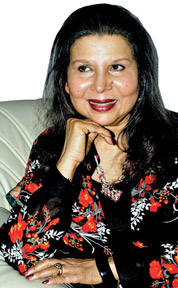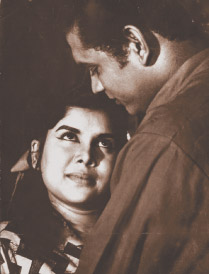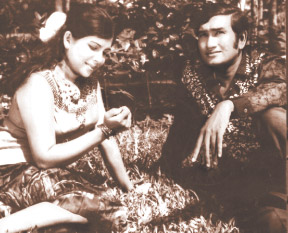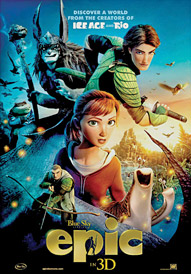|

WHY nobody can forget JK
Channa Bandara Wijekoon
Jeevarani Kurukulasuriya was not just an actress, she was a star. The
glamour and life brought to the silver screen by this alluring actress
is astounding and unforgettable. Her haunting beauty added colour to Sri
Lanka’s first ever Sinhala colour film, ‘Ran Muthu Doowa’.
|

Jeevarani Kurukulasuriya. Picture by Ranjith Asanka |
Movie fans of yesteryear were stunned by her features. They realized
that there are local beauties that could surpass Bollywood actresses.
Youth not only vied to see Jeeva’s films but they also yearned to fall
in love with her. Dr Lanka who was slow and steady in his temperament,
eventually won her heart. This left a few male actors brokenhearted.
This is a glimpse at the trailblazing path of this stunning celebrity
called Jeevarani.
Q: Did you enjoy being a celebrity?
A: Yes of course I did. I worked hard to achieve stardom.
Q: How were you inspired to become a star?
A: When I was about three years old I developed the habit of
entertaining people. I used to dance, sing lullabies, poems and do
various mimics to draw the attention of my family members and relations.
The bed was my stage and the others used to sit on the floor, watch me
and applaud. I sang, danced and acted at Good Shepherd Convent as well.
Q: Was there someone to guide you on the way?
A: My father identified my talents and took me to Radio
Ceylon. He was my mentor. I became a ‘Lama Mandapaya’ singer. The late
Thilakasiri Fernando interviewed me and I was recognized as an “A” grade
artiste.
Thilakasiri and I recorded the song; ‘Maala Manamaaliya Wu Daa’ which
became a hit. I met Vajira Chitrasena and started attending Kandyan
dancing classes. I did dancing exams and got myself qualified in that
sphere too.
I used to watch Rukmani’s films. My passion for the arts reached its
height after seeing her performances. I tried to become Rukmani in front
of the mirror. I yearned to be an actress.
Q: Was your journey into movies a smooth-sailing venture?
A: I did the main role in the stage drama ‘Maa Henae Riri Yaka’,
a story written by the late S W R D Bandaranaike. It was staged 40
times.
|

With Gamini Fonseka in Ranmuthu Doowa |

In Bicycle Horu |
My father who knew about my ambition by this time took me to Dr.
Lester James Peries. Dr Peries was doing ‘Sandeshaya.’ The casting had
been already done. Yet he created a role for me (with dialogues) in ‘Sandeshaya.’
That was my ticket to Sinhala cinema.
Cinemas did ‘Veera Vijeya’ and offered the main role to me. My
grandmother accompanied me when I went to India for shooting. Then ‘Ran
Muthu Doowa’ came suddenly out of the blue. I couldn’t believe I was
offered the main role in the first colour film in Sri Lanka!
Q: You and Gamini performed for the song ‘Galana Gangaki
Jeevithe’ in ‘Ran Muthu Doowa’ in a very romantic manner.
A: They did a photo-shoot prior to shooting and I overheard
them saying “She is exactly who we want…” Gamini and I made a perfect
couple in the film.
The director was Mike Wilson. The climax scene was me being tied down
to a rock in the shallow seas. This scene was very long. We shot it for
a continuous six days. I was exposed to direct sun light while being in
the sea. I was shivering with fever on the final day. The location was
the Swami Rock in Trincomalee.
The witch-doctor (Kattadiya) who was going to sacrifice me to take
the treasure was none other than Thilakasiri Fernando who auditioned and
sang a duet with me at the Radio Ceylon. ‘Enna Madanalae’ was one of his
famous solos. Shane Guneratne who acted in the film was another actor
whom I admire. The first duets of Narada Dissasekera and Nanda Malani
came in the film. Taking part in the project was a dream come true for
me.
Q: You entered Sinhala cinema in a transition period. Artistes
like you, Gamini Fonseka, Ananda Jayaratne, Domie Jayawardena and
Piyadasa Gunesekera revolutionized the scene by bringing forth a natural
way of acting onto the screen.
A: True. That aspect began from ‘Ran Muthu Doowa.’ That is why
the film is a landmark in Sri Lankan cinema history. The film brought
forth natural acting. Gamini too believed in this type of acting. He
must have learnt that from David Lean when he worked as an assistant
director in ‘Bridge on the River Kwai’.
|

In Sheela |
Since I acted opposite Gamini in the film it was very easy to conform
to a similar acting style. Gamini was a good teacher. With the training
I had gathered on stage and in dancing and singing; it was easy for me
to grasp the finer points of this style.
When I watch teledramas today I feel happy to see how the young
actors and actresses have taken forward this trend with necessary
adaptations. The advancement in communications is a blessing for them.
Q: How was the association and rivalry between fellow artistes
at the time?
A: Gamini came to the scene and surpassed all the male actors.
He had all the attributes and the discipline’ to achieve this status. We
were good friends. He used to impress us by directing certain scenes in
his films.
We were really busy with various projects and hardly had any time to
make friends. Sandhya Kumari was very photogenic. Vijitha Mallika was my
contemporary. They had a good fanfare. Anula Karunatileke did different
kinds of characters. Instead of feeling jealous about each other we all
wanted to do a better role than the others.
This kind of healthy rivalry was there. It was for the betterment of
cinema. Sandhya was bold enough to take up villainous roles while we
stuck to being the heroine. We did not want to take that risk. I was
keen in positioning myself according to the wishes of my fans. Even
Gamini rarely played the villain.
Q: Were you approached by actors in a romantic manner?
A: I will reserve my comment. (smiles)
Q: Tell us about your family.
A: I got married when I was at the peak of my career. Many
fans came to my residence. There was no end of marriage proposals. Lanka
came to see me as a fan. Then he was coming in regular intervals and
that is how we developed our relationship.
The male actors did not like it much when Lanka came to the shooting
locations to pick me up. (giggles) We are married for 45 years now. Once
we went to see the Kandy Perahera. Fans mobbed the vehicle and were
trying to open the shutters to have a glimpse of me. The car was
obviously not air conditioned and we were almost suffocating. The police
had to interfere.
We went to Australia after spending five years of our marriage in Sri
Lanka. Before migrating I paved way for my sisters Shirani and Janakai
to act in films. Menik was very small then. Janaki did ‘Geetha’ and
Shirani acted in ‘Manamaalayo’ with Tony Ranasinghe. I had contributed
to an array of films: ‘Veera Vijeya’, ‘Bicycle Hora’, ‘Adata Wediya Heta
Hondai’,’ Okkoma Hari’, ‘Horungeth Horu’, ‘Senasili Suweya’ and ‘Sheela’.
My three daughters were babies when we migrated. The two younger
ones, Senani and Lankangani are doctors now and the eldest, Sajeewani,
is a nutritionist and a first-class singer. Lankangani is married to
Nalaka Edirisinghe and lives in Sri Lanka.
Q: Are you still in touch with your fans?
A: Yes. My fans are still in touch with me. They were behind
all my achievements. They want me to look young forever!
Blue the warmest colour at Cannes?
Deborah COLE
An epic lesbian love story with graphic sex, a Coen brothers musical
comedy and a blood-stained critique of Chinese society rocked the 66th
Cannes Film Festival but critics said no hands-down favourite had
emerged ahead of Sunday's prizes.
After 20 films in competition in what reviewers said was a fairly
strong year at the world's top cinema showcase, at least a quarter of
the pictures looked like possible winners of the Palme d'Or top award.
A jury led by Steven Spielberg and packed with fellow Oscar winners
Nicole Kidman, Ang Lee and Christoph Waltz among other luminaries was to
deliberate in seclusion at a villa in the hills above Cannes.
Critics swooned over French-Tunisian director Abdellatif Kechiche's
coming-of-age tale “Blue is the Warmest Colour” about a 15-year-old
girl's first love, an older woman. At three hours in length, the picture
follows the arc of lead character Adele's (Adele Exarchopolous) tender
passion for a beautiful blue-haired art student played by rising star
Lea Seydoux, while also exploring themes such as class in France and
women's careers.
“Sure to raise eyebrows with its show-stopping scenes of
non-simulated female copulation, the film is actually much more than
that: it's a passionate, poignantly handled love story,” a Hollywood
Reporter critic said.
“Remarkably, though, the explicit scenes never really feel
pornographic, especially since the film isn't about titillation or
arousal.” It topped critics polls in trade journals Screen International
and Film Francais as well as London bookmakers' rankings.
But reviewers wondered whether the jury would shy away from rewarding
its lengthy depictions of on-screen lovemaking -- among the most
explicit in Cannes competition history.
Joel and Ethan Coen's “Inside Llewyn Davis” starring Carey Mulligan,
Justin Timberlake and newcomer Oscar Isaac in the title role delighted
audiences with a mix of soulful 1960s folk singing and absurdist humour.
The Coens won Cannes in 1991 with “Barton Fink” and last joined the
competition in 2007 with “No Country for Old Men”.
China's Jia Zhangke offered a shocking look at rampant corruption and
exploitation of average citizens in his country that builds into a
violent rage with “A Taste of Sin”.
US website Salon called it “an art-house film with the body count of
a 'Die Hard' sequel while London's Daily Telegraph said it depicted
China as “cold and almost unnavigably vast; a place where sin may be the
the only thing we have to keep us warm.” Iranian Oscar winner Asghar
Farhadi made a strong showing early in the festival with “The Past” an
intricately structured drama about a patchwork family set in France.
Other likely contenders included US director Alexander Payne's
recession-era road movie “Nebraska” and lush Roman society portrait “The
Great Beauty” by Paolo Sorrentino.
AFP
The ‘Epic’ comes alive on screen
 ‘Epic’ is a 3D CG adventure comedy that reveals a fantastical world
unlike any other. From the creators of ‘Ice Age’ and ‘Rio’, ‘Epic’ tells
the story of an ongoing battle between the forces of good, who keep the
natural world alive, and the forces of evil, who wish to destroy it.
When a teenage girl finds herself magically transported into this secret
universe, she teams up with an elite band of warriors and a crew of
comical, larger-than-life figures, to save their world...and ours. ‘Epic’ is a 3D CG adventure comedy that reveals a fantastical world
unlike any other. From the creators of ‘Ice Age’ and ‘Rio’, ‘Epic’ tells
the story of an ongoing battle between the forces of good, who keep the
natural world alive, and the forces of evil, who wish to destroy it.
When a teenage girl finds herself magically transported into this secret
universe, she teams up with an elite band of warriors and a crew of
comical, larger-than-life figures, to save their world...and ours.
The film is directed by Chris Wedge and produced by Lori Forte and
Jerry Davis. Amanda Seyfried, Colin Farrell, Beyoncé Knowles, Josh
Hutcherson, Christoph Waltz, Aziz Ansari, Chris O'Dowd, Pitbull, Jason
Sudeikis and Steven Tyler have rendered their voices for the production.
‘Epic’ will begin unspooling at Savoy cinema, Wellawatte, form May 29.
No retreat
Channa Bandara Wijekoon
The Directors Guild of Sri Lanka stand by their word to support the
initiative taken by the National Film Corporation (NFC) to limit the
distribution and screening of new films to 35 copies. They firmly oppose
a particular producer’s intended action to screen over 55 copies of his
film.
The decision with regard to limiting productions to 35 copies was
taken by the NFC on January 1. The Director’s Guild supported this
initiative as a temporary measure while considering the grave situation
in the local cinema industry.
Sri Lanka has 160 cinema halls at present. Out of these only 80
cinema halls are equipped with essential facilities to provide a decent
entertainment environment to filmgoers. Considering this situation the
comments made by the producer to screen over 50 copies is seen as a
means of depriving other producer the right to screen their productions.
Further, this unethical intended action could be treated as challenging
a Government policy. It is an action which projects sheer selfishness
and is bound to worsen the situation of the industry.
The court has already given orders to implement this law. The
Government has already spent over two million rupees on this court case.
The Directors Guild believe that this law should remain till the new
state-of–the-art mini cinemas functioning under digital technology is
introduced to various areas of the island.
The Directors Guild comprises its President Prasanna Vithanage,
Secretary Bennette Rathnayake, members Dr Dharmasena Pathiraja, Dr
Malani Fonseka, Dr Sumithra Peries, Tissa Liyanasuriya, Chandran Rutnam,
Sunil Soma Peiris, Jayantha Chandrasiri, Asoka Handagama, Dharmasiri
Bandaranaike, Jackson Anthony and many more.
|





